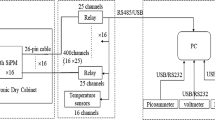Abstract
Background
JUNO (The Jiangmen Underground Neutrino Observatory) is a multipurpose neutrino experiment, and it has very strict requirements for the detector. According to the MC simulation for JUNO experiment requirements, the Rn concentration in the water of the veto detector should be less than 0.2Bq/m\(^{3}\). In order to measure such low Rn concentration, two kinds of high-sensitivity Rn measurement systems have been developed.
Method
Based on the water system of JUNO prototype, two kinds of high-sensitivity Rn detectors have been developed, namely the Si-PIN Rn detector and the LS Rn detector. The Si-PIN Rn detector uses a Si-PIN photodiode to detect the \(\alpha \) from \(^{214}\)Po decay and the LS Rn detector detects the coincident signals of \(\beta \) from \(^{214}\)Bi decay and \(\beta \) from \(^{214}\)Po decay.
Result
The background measurement of Si-PIN Rn detector and LS Rn detector is performed to estimate the sensitivity. The sensitivity of Si-PIN Rn detector is around 9.0mBq/m\(^{3}\) and the sensitivity of LS Rn detector is around 64.0Bq/m\(^{3}\).
Conclusion
Both of the Si-PIN Rn detector and the LS Rn detector are working well with the JUNO prototype at present, and both of them can be developed as an online Rn concentration monitoring device for JUNO veto detector.












Similar content being viewed by others
References
JUNO collaboration, J. Phys. G Nucl. Part. Phys. 43, 030401 (2016)
J. Kiko, Nucl. Instrum. Methods A 460, 272–277 (2001)
Y. Nakano et al., Nucl. Instrum. Methods A 867, 108–114 (2017)
S. Tasaka, ICRR Annual Report (April 1994–March 1995), ICRR, University of Tokyo, 1996, p. 36
M. Nemoto et al., Radioisotopes 46, 710 (1997)
Y. Takeuchi et al., Nucl. Instrum. Methods A 421, 334–341 (1999)
http://www.ortec-online.com/products/electronics/preamplifiers
http://www.ortec-online.com/products/electronics/amplifiers/671
78 mm (3) Photonmultiplier 9821QB Series Data Sheet, Electron Tubes Company (2002)
Y. Nakano et al., ar**v:1704.06886 (2017)
C. Mitsuda et al., Nucl. Instrum. Methods A 497, 414–428 (2003)
Y. Nakano et al., Nucl. Instrum. Methods A 867, 108–114 (2017)
Acknowledgements
This work is supported by **e Jialin Foundation of Institute of High Energy Physics (IHEP, Y7546150U2). Many thanks to **angcheng Meng, Guangpeng An of IHEP and Shoukang Qiu of University of South China for their help during the experiment.
Author information
Authors and Affiliations
Corresponding author
Rights and permissions
About this article
Cite this article
Zhang, Y.P., Liu, J.C., Guo, C. et al. The development of \(^{222}\hbox {Rn}\) detectors for JUNO prototype. Radiat Detect Technol Methods 2, 5 (2018). https://doi.org/10.1007/s41605-017-0029-8
Received:
Revised:
Accepted:
Published:
DOI: https://doi.org/10.1007/s41605-017-0029-8




